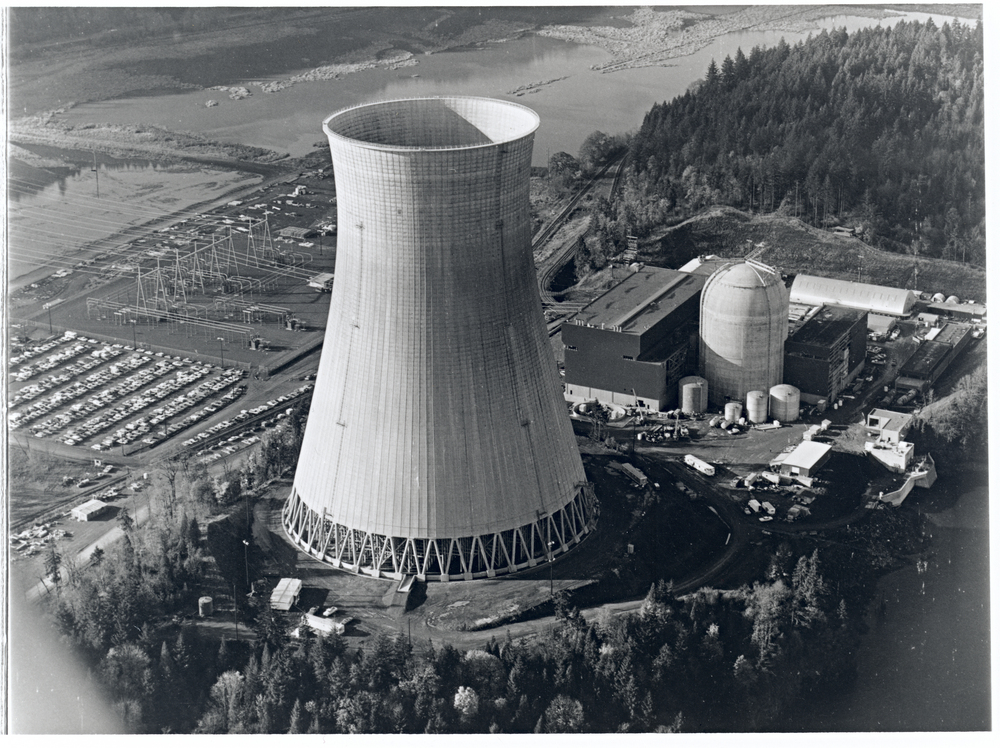The Trojan Nuclear Power Plant, located in Columbia County about twelve miles north of St. Helens, began generating power in March 1976. It shut down in January 1993. The saga of Oregon’s only nuclear-generating plant, however, played out over a period longer than the seventeen years it was in operation.
Portland General Electric (PGE), Trojan’s nominal owner, began exploring the idea of a nuclear plant as early as 1958 when, with fifty-one other utilities from around the nation, it operated an experimental plant at Peach Bottom, Pennsylvania, under the auspices of the federal government. The smooth operation of that facility and the then-prevalent view that nuclear power would be “too cheap to meter,” in the words of Admiral Lewis Strauss, head of the Atomic Energy Commission, persuaded PGE that it could operate a reactor of its own. The utility began serious planning for a plant in 1967, eventually choosing a site owned by the Trojan Powder Company.
Trojan was conceived as a solution to the anticipated explosive growth of the PGE service area (largely metropolitan Portland) and the Pacific Northwest. The regional utility industry, both public and private, was convinced of the looming need. As a result, while PGE was the majority owner of the plant (with a 67.5 percent stake), thirteen other utilities had stakes in the plant as well, including Pacific Power and Light (2.5 percent) and the Eugene Water and Electric Board (30 percent).
Construction of Trojan began on July 30, 1968. There were intrinsic difficulties in building a nuclear plant at the time. First, there were five different reactor types then current, each built by a different company (Trojan's was a pressurized water reactor). Thus, there was no standardization in the industry, making maintenance and repair problematic.
Second, experts believed there could be no such thing as a small nuclear power plant; each one had to be massive, with enormous output, in order to be economical. When Trojan came on line, it was the biggest plant of its kind. The huge cost of construction ($450 million) was justified in PGE’s 1966 Annual Report: “the era of wholly economical hydroelectric power” was ending, and Pacific Northwest utilities would soon begin the transition to forms of thermal power, such as coal. “Inevitably,” the report continued, “nuclear power will be a major factor.” While the agreement with other utilities was designed to spread fiscal and other responsibilities, PGE’s preeminence in the plant’s financing and output placed chronic heavy cost and public relations burdens on the company, generating tensions between it and its ratepayers that would never be fully dissipated.
Third, Trojan was burdened with the company’s assumptions about the inevitability of nuclear power. Implicit in this perspective was PGE’s view that the public would understand the necessity of augmenting the regional load with thermal generation and that nuclear was more desirable than coal or other forms of “dirty” thermal power. PGE also believed that the higher cost of such power would be accepted, because no other kind of generation could be as cheap as hydro.
The assumption that nuclear power would be a cheap form of thermal generation turned out to be far off the mark, in large part because of Trojan's high construction cost and its constant maintenance problems. The rates were a particular shock to local consumers accustomed to rock-bottom Pacific Northwest charges for hydropower. Throughout the post-World War II period, Northwest ratepayers generally paid half as much for electricity as users anywhere else in the world. As a result, they used twice as much electricity as other users. In the Trojan era, however, PGE persistently returned to the Public Utilities Commission for rate increases, irritating the region's heavy consumers.
The fourth and most critical point was that as the plant was being built, the anti-nuclear movement grew into a powerful force in Oregon, as it did elsewhere in the nation. In addition to its steadfast opposition to nuclear power, the anti-nuclear movement’s hostility to Trojan was fueled by two facts that focused its objections. In 1978, a major geological fault line was discovered running through the Trojan site, creating the specter of an earthquake that could trigger a nuclear disaster. At the same time, no universally satisfactory solution to the problem of nuclear waste disposal was ever introduced into the debate over nuclear power and, in Oregon, over Trojan.
As concern about these issues spread from environmental and anti-nuclear activists to large segments of the general public, fierce and chronic opposition to Trojan grew. In August 1977, the Trojan Decommissioning Alliance staged the nation’s first occupation of an operating nuclear power plant. Led by activists Nina Bell and Norman Solomon, the occupation drew immense attention to Trojan issue and resulted in eighty-two demonstrators being arrested. The plant’s most persistent critic over the long haul, however, was Lloyd Marbet of a group called Forelaws on Board (FOB). Although Marbet had not participated in the 1977 occupation, he and others pressed ballot initiatives and lawsuits from 1978 to 1995 to end Trojan’s operation and to prevent PGE from passing on construction costs to ratepayers.
Trojan began generating commercial power on May 20, 1976, with a capacity of 1,130 megawatts. From the outset, the plant was plagued by design flaws and other problems that led to temporary closures and expensive repairs. In 1978, for example, Trojan was shut down for nine months while modifications were made to improve its resistance to earthquakes following the revelation of significant construction problems. PGE and its partners sued Bechtel over the construction issues, and an undisclosed out-of-court settlement was eventually reached.
In the 1992 statewide elections, Trojan was the target of two ballot measures, one sponsored by Marbet and FOB and another by a local businessman and his wife, both aimed at closing it down. PGE fought back with a $5 million campaign, one of the most expensive in Oregon political history. The measures were defeated, but a month later, the discovery of a steam generator tube leak (a recurrent problem for the facility) forced closure of the plant for repairs. That was followed by another sort of leak—one of documents from scientists of the Nuclear Regulatory Commission suggesting that Trojan could be unsafe to operate.
In January 1993, facing continuing costs of maintenance and repair and defending the plant from its detractors, PGE began decommissioning Trojan, some twenty years before the projected end of its useful life. It was a laborious process to eliminate the radioactive material from the site to make it suitable for other uses. In 2001, Trojan’s massive reactor was enclosed in concrete foam, sheathed in blue shrink-wrapped plastic, and barged up the Columbia River to the Hanford Nuclear Reservation in Washington. There it was buried in a forty-five-foot deep pit and covered with six inches of gravel. It was the first commercial reactor to be moved and buried in one piece, the largest such device to be decommissioned. In May 2006, the 500-foot-tall cooling tower was imploded.
Nearly 800 spent fuel assemblies are in dry cask storage on the original Trojan site, awaiting a permanent storage or disposal solution to be presented by the Department of Energy.
-
![]()
Trojan Nuclear Plant in 1973..
Oreg. Hist. Soc. Research Lib., ba020030
-
![]()
"Vote Yes/9 for Safe Energy" political sign, 1976.
Oregon Historical Society Museum Collection, 96-42.20 -
![]()
"Yes on 6 Close Trojan Now" bumper sticker, 1992.
Oregon Historical Society Museum Collection, 92-7.112
Related Entries
Related Historical Records
Map This on the Oregon History WayFinder
The Oregon History Wayfinder is an interactive map that identifies significant places, people, and events in Oregon history.
Further Reading
Koberstein, Paul. “Trojan: PGE's Nuclear Gamble.” Willamette Week, March 9, 2005.
Nipper, Gregory. "Progress and Economy: The Clash of Values over Oregon's Trojan Nuclear Plant." M.A. thesis, Portland State University, 2005.




